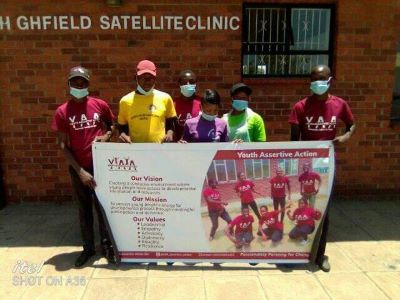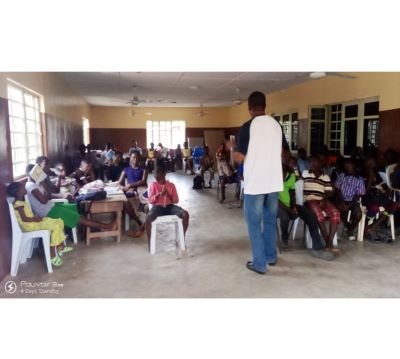Regina Rumbidzai Pasipanodya
With the upsurge in drug and substance abuse in Zimbabwe, a common cancer that has severely affected the most communities in the country, Clide Chimbi (28) from Hopley has taken it upon himself a responsibility to save the youths in his community.
Hopley is a peri-urban community in Harare that has an estimated population of nearly 60,000 people according to the 2018 Zimstat report.

The settlement is largely contested and characterized by lack of basic services exposing the residents to intimidation, abuses and poverty.
Understanding the nature of his community, which is one of the less priviledged communities in Harare with high rates of crime, prostitution and poverty, Chimbi has introduced an anti-drug abuse initiative under the name “Tariro Arts Group”.
Tariro Arts Group brings together young people from the community to engage in various forms of art, such as dancing, public speaking, and acting.

The main goal of this initiative is to keep the youth occupied and prevent them from falling into drug and substance abuse in Hopley.
Started in 2022, the project still has a long way to go in addressing drug abuse in the community, but there have been notable achievements despite the slow progress, according to Chimbi.
In 2021, an inter-ministerial committee established by Zimbabwe’s President Emmerson Mnangagwa developed the Zimbabwe National Drug Master Plan (ZNDMP 2020 to 2025) and Treatment and Rehabilitation Guidelines of Alcohol and Substance Use Disorder of Zimbabwe (TRGASUD ZIM). However, there has been no public disclosure of the progress and accomplishments achieved under this plan.
Despite the absence of official government statistics on the prevalence of illicit drugs in the country, a World Health Organization (WHO) report on the mental health of young people in the African region points out that Zimbabwe has the highest number of 15-19 year-olds engaging in heavy episodic drinking.
Based on a 2019 report from the World Health Organisation (WHO), Zimbabwe ranks highest in Africa for the percentage of 15 to 19-year-olds engaging in heavy “episodic drinking”, with 70.7% of males and 55.5% of females participating. Unfortunately, this age group is also heavily involved in the distribution and use of drugs.
The Zimbabwe Civil Liberties and Drug Network states that the order of substance abuse in terms of prevalence is cannabis (67%); cough syrup (47%); crystal meth (36%); illegal alcohol (31%); pharmaceuticals (13%); crack (3%); cocaine powder (3%); and heroin (2%).
A recent study conducted by UNICEF in 2022 unveiled that many young people who fall victim to substance abuse do so as a way to cope with different pressures, such as poverty, and to feel better.
However, the impact of addiction on communities can be devastating, leading to an increase in violence, theft, joblessness, and the necessity for more rehabilitation.
Chimbi stated, “To combat this, Tariro Arts Group has been working to keep young people involved in various activities as a preventive measure against substance abuse.”
Approximately 20 young individuals have become members of the Tariro Arts Group and regularly gather for classes and other responsibilities.
Chimbi mentioned, “We are a group of 20, consisting of eight boys and 12 girls, and we conduct our programs at Rising Star Primary School in Hopley every Wednesday and Friday. Our intention is to seek donations and opportunities for employment so that we can make a living through creative centres.”
According to local media, in addition to imported drugs, there is an influx of cheap, highly potent alternatives such as musombodiya, which is a colorless drink made from ethanol and embezzled powders. These substitutes are mainly produced and distributed at bus terminals and in the ghettos. It has been reported that young addicts are resorting to boiling diapers and bleach products, then inhaling the vapors as a form of intoxication. Nineteen-year-old Arnold Mukute credits the Tariro Arts Group for helping him overcome drug abuse, which he started at the age of 15 due to peer pressure from other boys at school. The group saved his life from addiction.
When I heard about Tariro Arts Group at first I went there just for fun but now this program has helped me overcome the addiction. I managed to finish my studies and I am currently doing a course in welding,” said Mukute.
ActionAid Monitoring and Evaluation Officer, Itayi Viriri said lack of opportunities in Zimbabwe especially in communities like Hopley has been the major contributing factor to drug and substance abuse.
“According to our research, the findings pointed out that most youths in Hopley are just sitting idle with no source of income. This has seen most of them being exposed to drugs,” said Viriri.
He further applauded the youths for introducing an initiative as TAG that seeks to address drugs problems in Hopley and urged collective measures from all stakeholders to find long term solutions that would promote income generating projects in Hopley.
“Drug abusers can take anything that they think will keep them euphoric or sedated and cases of organic psychosis are on the rise,” says Dr Johannes Marisa, president of the Medical and Dental Private Practitioners’ Association of Zimbabwe.
He adds that there is a need to have more rehabilitation centres as the country is grappling with the number of drug addicts in need of rehabilitation.
“Rehabilitation centres for drug addicts are quite a few in our country, and the private sector can play a significant role in establishing such centres. It is difficult for an addict to abruptly stop drug abuse, hence the need for rehabilitation at secluded places,” Marisa adds.




